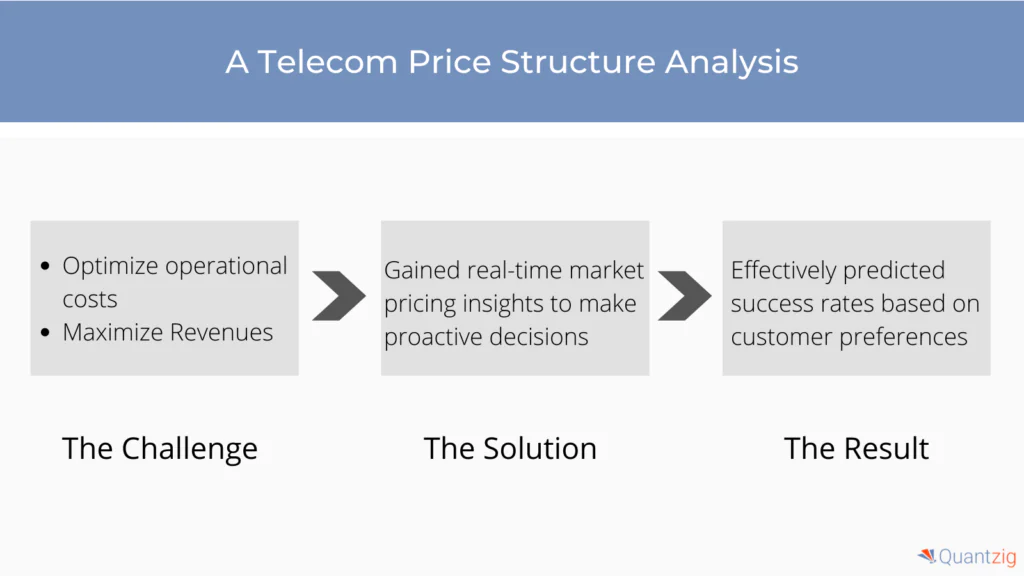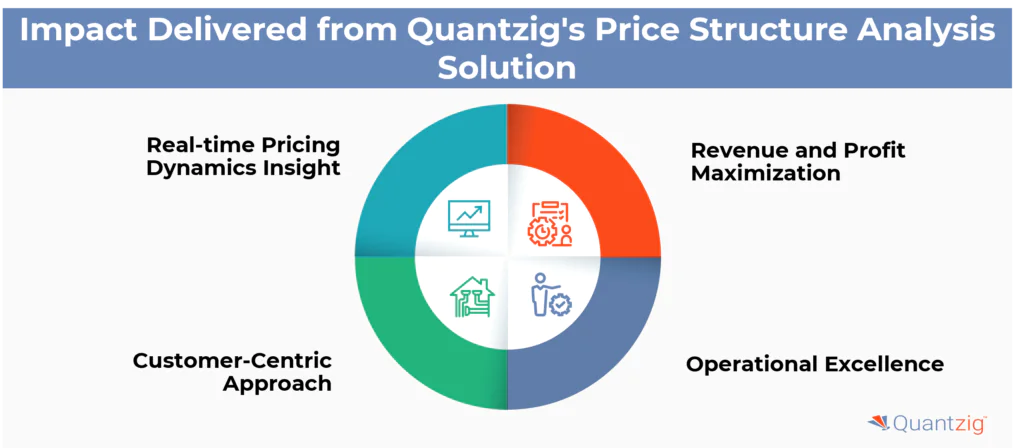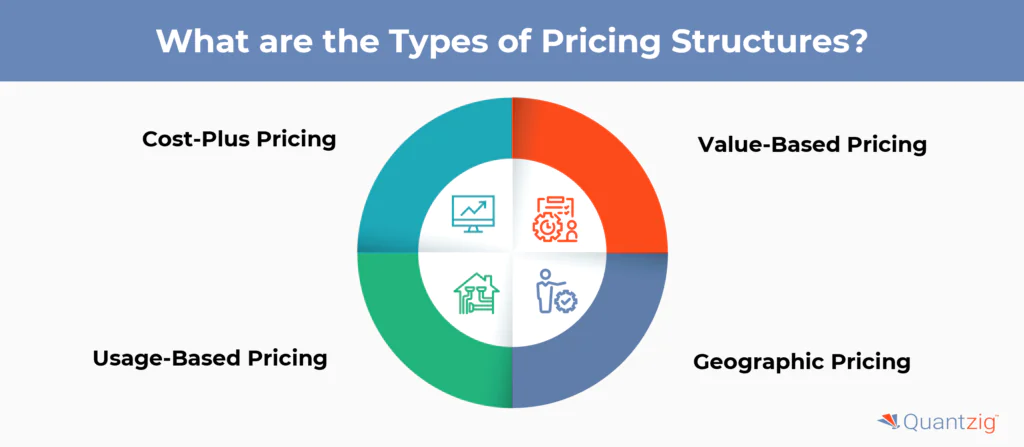Written By: Sudeshna Ghosh
Table of Contents
Introduction to Price Structure Analysis
A company’s method and justification for setting prices for its products or services is called a pricing structure. It’s an essential part of a company’s overall strategy because it influences both profitability and the way the market views the company’s products.
Our client, a renowned global telecommunication service provider, faced the challenge of optimizing operational costs, maximizing revenue, and navigating intense competition. Conducting a pricing audit allowed them to evaluate their products and services against core price points and offers in the market, aligning their strategy with customer value and competitive value. Through this Quantzig’s comprehensive approach, our client aimed to position themselves strategically in the market and drive profitability while meeting the evolving needs of their customers.
Book a demo to experience the meaningful insights we derive from data through our analytical tools and platform capabilities. Schedule a demo today!
Request a Free DemoWhat is a Price Structure Analysis?
A Price Structure Analysis is a methodical evaluation of all the costs associated with production, distribution, and marketing that go into determining the ultimate price of a good or service. It also considers outside factors like competition and market demand. Businesses can improve pricing strategies to increase profitability and sustain a competitive edge with the help of this analysis.
Quantzig’s Expertise in Price Structure Analysis Solution for a Global Telecommunication Service Provider
| Particulars | Description |
| Client | A global telecommunication service provider |
| Business Challenge | Difficulty understanding pricing structures of competitors |
| Solution Impact | Identified price points, maximized sales and profits |

About the Client
The client is a renowned telecommunication service provider with a considerable number of services spread across the globe with a minor portfolio in the textile industry as well. The client is extremely renowned among the people.
Price Structure Analysis Challenges Faced by the Client
1. Competitive Pricing Complexity:
- Grappling with the complexities of understanding and dissecting the pricing structures adopted by industry competitors.
- Navigating through diverse models prevalent in the highly competitive telecom market.
2. Service Portfolio Enhancement:
- Identifying avenues for the introduction of innovative services aligned with emerging market demands.
- Streamlining and optimizing customer service operations to ensure heightened customer satisfaction and sustained revenue growth.
3. Harnessing Internal Data:
- Exploring the untapped potential of leveraging internal data for comprehensive network optimization.
- Deploying data-driven insights to perform precise customer segmentation, ensuring targeted strategies for revenue maximization.
4. Operational Efficiency Challenges:
- Addressing operational inefficiencies within the telecom network to streamline processes and reduce costs.
- Identifying opportunities for resource optimization and overall operational enhancement.
Quantzig’s Price Structure Analysis Solution for the Client
1. Thorough Price Structure Analysis:
- Conducting a comprehensive analysis of the client’s pricing structure in correlation with those of key competitors.
- Recommending adjustments and optimizations to enhance competitiveness in the dynamic telecom market.
2. Strategic Service Expansion:
- Proposing and implementing new services based on a thorough understanding of market trends and customer preferences.
- Developing strategies to optimize customer service operations, ensuring increased efficiency and satisfaction.
3. Unlocking Data-Driven Insights:
- Employing advanced analytics to extract actionable insights from internal data reservoirs.
- Utilizing data-driven strategies for effective network optimization, customer segmentation, and revenue maximization.
4. Operational Optimization Framework:
- Implementing a comprehensive framework to address operational inefficiencies within the telecom network.
- Identifying and executing strategies for resource optimization, leading to enhanced operational efficiency.
Experience the advantages firsthand by testing a customized complimentary pilot designed to address your specific requirements. Pilot studies are non-committal in nature.
Request a free pilotPrice Structure Analysis Solution Predictive Insights
- Effectively predict the approximate success rate based on customers preferences
- Estimate the impact of pricing on sales volume
- Gain a clear and precise understanding of the customer base and their expectations
- Segment the customers and deliver personalized offerings
- Assess the impact of price differentials on the market share
Impact Delivered from Quantzig’s Price Structure Analysis Solution

1. Real-time Pricing Dynamics Insight:
- Acquired real-time insights into the dynamic industry landscape of the telecom market.
- Enabled proactive decision-making to adjust strategies and maintain competitiveness.
2. Revenue and Profit Maximization:
- Identified optimal price points to simultaneously maximize both sales and profits.
- Capitalized on cross-selling opportunities to further augment revenue streams.
3. Customer-Centric Approach:
- Evaluated customer behavior to predict potential churn, allowing for strategic marketing efforts.
- Implemented personalized offerings to enhance customer satisfaction and overall return on investment.
4. Operational Excellence:
- Addressed operational inefficiencies, leading to streamlined processes and reduced costs.
- Successfully optimized resources for enhanced overall operational efficiency.
Embracing a holistic approach, the telecommunication service provider not only navigated the intricacies of competitive pricing but also diversified services, improved customer satisfaction, and optimized operations. The strategic utilization of internal data propelled the company towards efficient network management, targeted customer engagement, and ultimately, improved profitability in the dynamic telecom sector.
Get started with your complimentary trial today and delve into our platform without any obligations. Explore our wide range of customized, consumption driven analytical solutions services built across the analytical maturity levels.
Start your free trialIndustry Overview

Today, the telecom industry is more concerned about increasing profitability by maximizing acquisition, enhancing customer loyalty, and minimizing customer churn rates. Also, leading service providers in the telecom industry are relying on price analysis to optimize price and minimize default rates to improve customer service and satisfaction. Also, telecom companies are advocating the need for price analysis to identify the most profitable customers and target the right audience through effective customer segmentation. Furthermore, with the help of price analytics, renowned companies in the telecom space can enhance their salesforce effectiveness and enhance marketing spends to optimize their ROI.
By considering factors such as page design, variable pricing models, and financial premium offerings, telecom companies can tailor their deployments and scale their services to enhance market appeal and cater to larger clients. Implementing a hybrid pricing structure allows companies to accommodate ‘regular-sized’ customers while also offering feature packages and per-user pricing for SaaS subscribers. Analyzing linear growth potential and implementing usage-based models based on factors such as infrastructure usage, API requests, transactions processed, and data used, enables telecom companies to cater to price-sensitive market areas while maximizing revenue forecasts.
A Pricing Structure: What Is It?
A company’s method and justification for setting prices for its products or services is called a pricing structure. It’s an essential part of a company’s overall strategy because it influences both profitability and the way the market views the company’s products. The type of goods or services they provide
- The intended audience’s buying power
- Price sensitivity within the industry
- Competition
- Cost arrangement
- Objectives and goals for marketing
- Stage of company growth
Most industries have a clearly defined pricing structure that serves as a guide for newcomers. For example, most SaaS providers combine usage-based, flat-rate, and tiered pricing structures. For these companies, this structure is perfect because it enables them to maximize revenue without sacrificing customer value.
What are the Types of Pricing Structures?

A price structure analysis evaluates various pricing methods and pricing plans to maximize revenue and profitability for businesses. By analyzing market competitiveness and implementing strategies such as price skimming or a fixed price approach, companies can develop an effective pricing model. This ensures they remain competitive while optimizing their financial outcomes.
1. Cost-Plus Pricing
Among all pricing structures, cost-plus pricing is one of the simplest. The equation is easy to understand: Final Price = Production Costs + Desired Profit
Although it is simple to compute, it may overestimate or underestimate a product’s actual value. You won’t take into consideration the true value your product offers to customers if you just consider your expenses.
2. Value-Based Pricing
Value-based pricing is centered on figuring out how much a product’s perceived value will get you as a customer. Product value is considered holistically by this pricing structure:
- How well a product helps users solve a problem
- The product’s quality
- Its distinctiveness and distinction from rivals
- Actual customer willingness to pay information
3. Usage-Based Pricing
Usage-based pricing schemes are appealing to consumers who would rather pay for what they genuinely use because they match expenses with customer usage patterns. This pricing model, which is popular among subscription-based businesses, typically consists of tiers with varying features and usage caps.
For instance, a business might provide a 100 GB storage plan for $10 per month, with an additional $5 per 50 GB after that.
Another popular usage-based model that is frequently observed with software platforms is per-user pricing. Regardless of how much a user uses the product, there will be a fee per user in this case. A business might charge $5 per month for each extra user after the first five are added to a $15 plan.
4. Geographic Pricing
Businesses utilize geographic pricing, an e-commerce pricing strategy, to determine prices for various cities, countries, and regions. Shipping charges, taxes, and cultural disparities can influence a customer’s willingness to pay for a product based on their location.
When considering international markets, where prices may differ due to fluctuating currencies and cost of living, this type of price localization is very helpful. But to make it financially viable, companies must establish strong logistics networks and realize economies of scale.
Pricing Structure vs. Pricing Strategy: What’s the Difference?
When discussing pricing, you might expect to encounter buzzwords like penetration pricing, price skimming, and product line pricing. However, it’s essential to understand that pricing strategy and pricing structure are not the same.
Pricing Structure
This encompasses your entire approach to pricing within your company, with a particular focus on how your pricing aligns with the features of your product and its impact on customer usage.
Pricing Strategy
This is more focused on the competitiveness of your product in the market rather than on your customers. Even unique products with inherent value will face competition. The pricing strategies involve setting price points to position your product competitively in the eyes of potential buyers.
Although related, these terms serve different purposes. Pricing strategy is the market-facing component of your pricing structure and should complement it.
How can Quantzig Help the B2B Businesses with Price Structure Analysis?
To further improve customer experience and maximize profitability, leading companies in the telecom industry are approaching companies like Quantzig. Quantzig’s price analysis solution helps companies estimate the impact of pricing on sales volume and enhance the customer experience. Moreover, the client was able to optimize service pricing based on revenues and profitability. By utilizing Quantzig’s expertise in B2B pricing and implementing a monetization approach that prioritizes flexibility and dynamism, telecom companies can tailor their offerings to better suit the needs of their target market and audience.
Through continuous product improvements and careful consideration of ethical limitations, companies can maximize revenue per sale while maintaining the quality of service and their market position. Quantzig’s survey methodology enables companies to identify the highest potential for profit and establish a reliable price point for their products and services, ultimately improving sales performance and customer satisfaction. To learn how we can help you optimize the trade-off between price, volume, and profit margins to maximize productivity and drive growth.
What does the Future Hold of Price Structure Analysis?
In conclusion, this case study on price structure analysis in the telecom industry highlights the critical role of strategic pricing in driving business success. By rigorously analyzing products, understanding prices, and recognizing the value of services offered, the client could adjust their competitive strategy to meet market demands. Various factors such as cost structures and types of services were evaluated to determine an effective policy and pricing framework.
The businesses within the telecom sector can take this example as a benchmark for the steps required to achieve a competitive edge in the marketplace. These tips and examples illustrate the difference an optimized strategy can make. By considering the option to analyze pricing tactics, including pricing optimization and decision processes, companies can stay ahead of pricing trends and apply the latest pricing methods and pricing techniques.
Conclusion
A thorough pricing evaluation against established pricing benchmarks ensures that the prices reflect the true value of the offerings. The detailed price structures underwent a meticulous cost analysis to ensure alignment with the overall business architecture, utilizing costing and rate structure analysis. The cost structure analysis revealed potential areas for refinement within the existing cost structures, and a structural analysis was conducted, with price structural analysis providing further insights.
The resulting pricing strategy can be visualized in a graph or template, serving as a model for startups and included in a business plan slide or spreadsheet. This approach also contributes to a deeper understanding of the market structure, often depicted in a diagram. Industries such as the textile and automobile industry can adapt these findings to their context, using them as a canvas for developing their own trading strategies. Investors, often referred to as smart money, can use these insights for technical analysis of agricultural commodities. Finally, the insights garnered from this study can be effectively communicated through a pitch deck.

